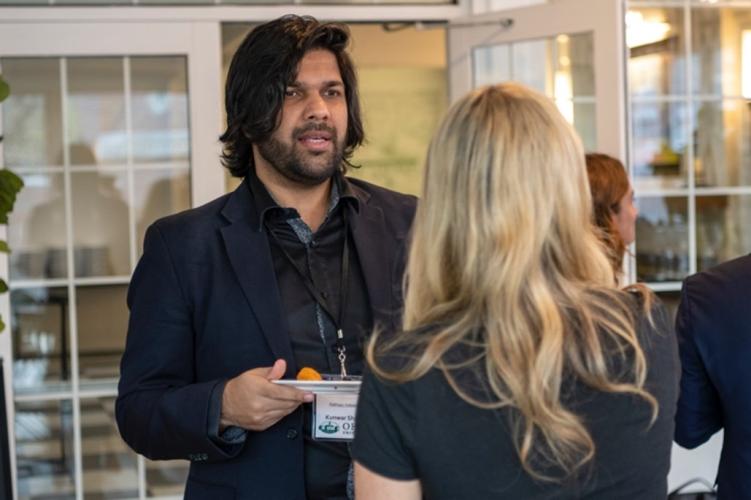
Kiplinger Journalism Fellowships highlight global reach of Ohio University

The E.W. Scripps School of Journalism is celebrating the 100th year of journalism instruction at Ohio University. In conjunction with the centennial, friends and alumni are highlighting the University’s journalism legacy. In this installment, journalist-educator Kevin Z. Smith of the Kiplinger Program highlights the international reach of Scripps.
For Pakistani journalist Kunwar Khuldune Shahid, a Kiplinger Fellowship and time in the United States focusing on political coverage and saving democracy wouldn’t just be essential to his work. It would be transformative to his career.
As one of the 2023 Kiplinger fellows, Shahid adds his name to the more than 500 journalists over the past 50 years to travel to Ohio to “retrain, refocus and rejuvenate” by way of Kiplinger. Made up of fellows from the United States and various other nations, Kiplinger’s mission to allow working professional journalists to spend time on campus learning, collaborating with colleagues and discovering better ways to do their all-important work is a philosophy that fits perfectly with that of the E.W. Scripps School of Journalism, no stranger to international collaborations.
Much of the Scripps School of Journalism’s decades-long commitment to international engagement is outlined in 40 pages of The Scripps School, Its Stories, People and Legacy, a 2019 publication detailing the start and sustainment of Scripps’ global outreach. From here one can read about everything from the early visions, to the financing and curriculum changes.
A vision and start
In the early 1970s, the visions and planning of two professors – the late John R. Wilhelm and Ralph F. Kliesch, set the table for what was to be the start of many international liaisons with media outlets and reciprocal universities around the world.
Wilhelm relied on his personal and professional connections from his days as a World War II correspondent to leverage financial support from a number of noted former foreign correspondents, such as Cornelius Ryan, a best-selling book author and journalist who reported from the beaches of Normandy on D-Day. These gifts spawned the John R. Wilhelm Foreign Correspondence Internships, which would propel students with desires of being a foreign correspondent overseas. They are still offered each year.
According to the Scripps records, since 1970, 280 students have done internships abroad, working for newspapers, magazines, online, wire services, TV and radio outlets, as well as public relations firms. They’ve found themselves in locations like Tel Aviv, Mexico City, London, Amsterdam, New Delhi, Tunis, Phnom Pehn and Jerusalem working for such outlets as AP, CNN, ABC News, Bloomberg, the Washington Post, Los Angeles Times and The Nation.
In the case of Kliesch, over a period of several years, he gathered more than 100 OHIO students and took them on tours of London, Paris, and other media centers visiting global news services like The Associated Press, United Press International and Agence France Press “for a chance to talk with high-level media practitioners.”
Leipzig agreement
More than just internships, study aboard for Scripps can mean entire semesters studying in classrooms with their international counterparts. Such was the case when Scripps developed an academic relationship with Leipzig University in the eastern German city of the same name.
This partnership was started in 1992 with the communication institute at Leipzig as the town and university were still trying to develop from decades of Soviet rule. In 1999 The Ohio-Leipzig European Center (OLEC) was established and the first group of Ohio University students were admitted to Leipzig’s European studies programs. Through an agreement, students from either Leipzig or OHIO could study on each other’s campuses and later undergraduate students could consider pursuing graduate degrees at the reciprocating schools.
International Institute of Journalism
To help carry out its international mission, the Institute for International Journalism (IIJ) was formed in 1997 as part of the School of Journalism. In what was considered at the time to be a peculiar arrangement of global support, the school of journalism unveiled the $150,000 Sing Tao Center, the result of Scripps faculty engaging Hong Kong publisher Sally Aw Sian by way of faculty member Chang Kuo-sin. Chang came to OHIO as part of an academic exchange with Hong Kong Baptist College.
To this day, headed by Dr. Jatin Srivastava, the IIJ continues to carry out many of the school's international initiatives. Its goals are to prepare students to work as international journalists, support research on topics related to international journalism, enhance communication among journalists, students, and media scholars, and cooperate with global partners in journalism education.
The idea that international journalism can emanate from a small town in southeast Ohio may seem farfetched to many people, but after five decades of living proof, it’s hard to imagine that there is anything in Scripps’ future but more global travel, more international cooperative agreements and more student life-altering experiences for the foreseeable future.
Journalist-educator Kevin Z. Smith is Executive Director of the Kiplinger Program in Public Affairs Journalism at Ohio University. He served as President of the Society of Professional Journalists, 2009-2010.
